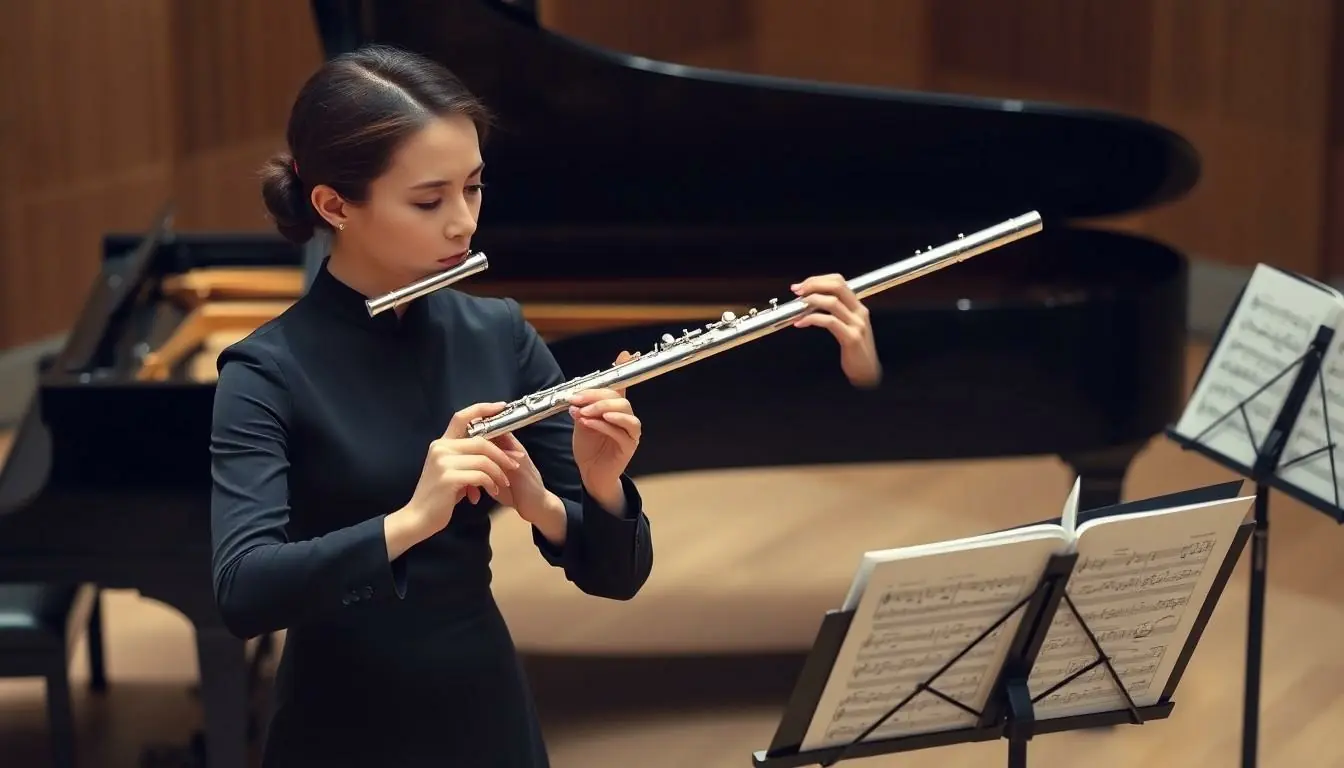Imagine a world where melodies dance through the air, carried by the sweet sound of a flute. Classical flute sheet music unlocks this enchanting realm, inviting both seasoned musicians and eager beginners to discover their inner virtuoso. Whether it’s the soaring notes of a Mozart concerto or the delicate whispers of a Bach sonata, each piece offers a chance to connect with timeless artistry.
Table of Contents
ToggleOverview of Classical Flute Sheet Music
Classical flute sheet music serves as a vital resource for musicians to explore this exquisite instrument’s repertoire. Access to sheet music enhances the practice and performance experience for flutists.
Importance of Sheet Music for Flutists
Sheet music provides structure and guidance, essential for developing technical skills. It allows flutists to interpret compositions accurately and expressively. Relying on established scores fosters a deeper understanding of music theory. Engaging with sheet music enables musicians to collaborate with ensembles effectively. Classical flute sheet music also opens doors to diverse stylistic interpretations, enriching their musical journey.
Key Features of Classical Flute Sheet Music
Classical flute sheet music contains unique symbols and notations, specifically designed for accurate reading. Dynamics, articulations, and phrasing instructions guide expressiveness in performance. Detailed fingerings often accompany complex passages, aiding in technique. Additionally, arrangements vary in difficulty, catering to different skill levels. Annotated editions provide historical context, enhancing interpretation and appreciation. Overall, well-structured sheet music serves as a foundation for both personal and collaborative growth in flute performance.
Types of Classical Flute Sheet Music

Classical flute sheet music encompasses various styles, catering to different performance settings and preferences. Musicians can explore numerous formats that highlight the flute’s versatility.
Solo Flute Pieces
Solo flute compositions feature the instrument’s expressive capabilities. Numerous works, such as Bach’s sonatas and various contemporary pieces, highlight technical skills. Challenging compositions often appear in collections designed for advanced players. Lesser-known pieces provide opportunities for discovery and expansion of repertoire. Solo sheet music demands attention to phrasing, dynamics, and articulation, emphasizing the musician’s interpretive choices.
Flute with Piano Accompaniment
Flute and piano arrangements create a rich harmonic environment. Composers like Mozart and Poulenc highlight interactions between flute and piano, showcasing the dialogue between the two instruments. These arrangements typically offer contrasting roles, with the flute carrying the melody while the piano provides harmonic support. Several graded pieces cater to various skill levels, making them accessible for both amateurs and professionals. Musicians benefit from the collaborative nature of these scores, enhancing their ensemble playing skills.
Flute Ensembles and Orchestral Parts
Flute ensembles and orchestral parts allow for rich collaborative experiences. Various ensemble formats, from duets to larger groups, emphasize harmony and blend. Orchestral scores often include specific flute parts, each contributing to the overall texture of the piece. Ensemble arrangements challenge musicians to listen and adjust to their surroundings, fostering a sense of teamwork. Accessing orchestral parts equips musicians with familiarization of traditional and contemporary works, enhancing their performance versatility.
Notable Composers of Classical Flute Music
Classical flute music features many notable composers who shaped its repertoire.
Johann Sebastian Bach
Bach significantly contributed to the flute’s repertoire with works like his Sonatas for Flute and Harpsichord. These compositions display intricate counterpoint and intricate melodies. His Partita in A minor particularly showcases the flute’s lyrical capabilities. Musicians appreciate Bach’s attention to ornamentation and expressiveness, making his pieces essential for any flutist’s study. Additionally, his influence extends into modern interpretations, enhancing the flute’s role within chamber music.
Wolfgang Amadeus Mozart
Mozart’s contributions include both flute concertos and chamber pieces, showcasing the flute’s versatility. The Flute Concerto No. 1 in G Major remains a staple in performance. This concerto highlights technical brilliance while offering melodic beauty, captivating audiences consistently. Moreover, Mozart composed the Andante in C Major for flute and orchestra, which emphasizes the instrument’s lyricism. His innovative approach to orchestration and harmony set a standard for future compositions.
Claude Debussy
Debussy revolutionized flute music with his impressionistic style. His piece, Prélude à l’après-midi d’un faune, features a haunting flute melody that defines the work’s atmosphere. Flutists take pleasure in exploring the dreamlike quality of Debussy’s music. Sonatine for Flute and Piano further illustrates his ability to intertwine complex harmonies with fluid lines. He significantly expanded the technical and expressive range of the flute, leaving a lasting impact on the instrument’s repertoire.
Tips for Finding Quality Classical Flute Sheet Music
Finding quality classical flute sheet music requires some insight into available resources. Musicians need reliable options to enhance their practice.
Online Resources and Platforms
Numerous online resources offer extensive classical flute sheet music collections. Websites such as IMSLP provide free access to a wide variety of sheet music, including public domain works. Other platforms like MusicNotes allow users to purchase and download sheet music, offering both digital and printable options. Musicians can also explore specialized sites, such as Flute World, that focus on flute-specific materials. Engaging in online forums or social media groups dedicated to flute players fosters connections with other musicians who can recommend trusted sources and share sheet music recommendations.
Local Music Stores and Libraries
Local music stores serve as valuable hubs for classical flute sheet music. Many stores carry a selection of sheet music from various composers, providing an opportunity for musicians to try before they buy. Knowledgeable staff can help identify suitable pieces based on skill level and interests. In addition, public libraries often maintain collections of sheet music available for borrowing, offering another resource for musicians seeking new works. Checking community bulletin boards can also reveal local events, workshops, or exchanges where musicians might find unique or rare sheet music options.
Classical flute sheet music opens a world of artistic expression and technical growth for musicians at all levels. By engaging with the diverse repertoire, flutists can deepen their understanding of music while honing their skills. The structured guidance provided by sheet music not only enhances individual practice but also fosters collaboration within ensembles.
Exploring resources for quality sheet music ensures access to a wealth of compositions from renowned composers. This journey through classical flute music enriches the musical experience, allowing for both personal fulfillment and shared creativity. Embracing the beauty of these works inspires a lifelong passion for the flute and its enchanting melodies.



